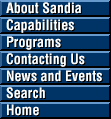|
Sandia’s new Gamma Irradiation Facility can test microchips, satellites, and everything in between
|

CELL INSIDE — Don Berry (left) and Norm Schwers of Sandia National Laboratories review procedures inside the largest of GIF’s three test cells, spacious enough to irradiate large objects such as tanks and satellites. (Photo by Randy Montoya)
Download 300dpi JPEG image, ‘GIFChamber.jpg’, 600K (Media are welcome to download/publish this image with related news stories.)
|
ALBUQUERQUE, N.M. — Sandia National Laboratories this week plans to conduct the first tests at the lab’s new Gamma Irradiation Facility, officially welcoming the GIF into the lab’s family of experimental nuclear facilities.
The facility can be used for space technology development, military systems vulnerability testing, nuclear reactor component development, and many other applications.
Objects as large as tanks or satellites and as small as microchips can be tested at the GIF for their abilities to withstand the damaging radiation environments they might experience in space, near stored nuclear materials, or during a wartime nuclear exchange.
“We are pleased to bring the new GIF on line to support our national security mission and our military, space, and nuclear energy customers,” says Sandia Nuclear Facilities Manager Ted Schmidt. “This facility has capabilities that will help satisfy many of the nation’s experimental gamma radiation needs for decades.”
The facility includes two 10 x 10-ft. test cells, one cavernous 18 x 30-ft. chamber that can accommodate large test objects such as

BIG DOOR -- Don Berry of Sandia National Laboratories operates the "door" to GIF's large test chamber, a 480,000-lb block of solid concrete that rides on air bearings.
Download 300dpi JPEG image, ‘GIFsafetydoor.jpg’, 456K (Media are welcome to download/publish this image with related news stories.)
|
|
weapon assemblies, military vehicles, or space equipment, and an 18-ft.-deep pool of water where underwater experiments can be conducted.
Pins made of radioactive cobalt-60 make up the gamma source arrays that are used to subject test objects, such as electronic components, to radiation.
Stockpile reliability
Subjecting nuclear weapons components and other electronic systems to a range of radiation types is an essential element of Sandia’s experimental capabilities and the lab’s support of DOE’s science-based stockpile stewardship mission.
When a nuclear weapon sits idle in the stockpile, its fissile materials give off a continual, low-level buzz of radiation, primarily gamma. Over time, this exposure can damage the weapon’s electronic components.
The hostile radiation environment a weapon or satellite experiences in space also can damage electronics. And in a nuclear exchange, a weapon’s detonation produces a burst of radiation that could destroy nearby electronic systems.
The ability to simulate neutron, X-ray, and gamma radiation effects in an experimental setting allows weapons and military systems designers to anticipate component failure or develop new systems that can withstand these radiation exposures. It also allows analysts to validate computer models that simulate radiation effects so that full-scale nuclear testing is not necessary.
Safety and security
More than 2,600 cubic yards — about 430 truckloads — of concrete was used in constructing the GIF’s chambers and pools. Its test cells feature 6-ft.-thick concrete walls, four-pane leaded-glass windows, and serpentine entryways that together virtually eliminate worker radiation exposures during experiments.
The cobalt source arrays move along underwater tracks beneath the test cells and are automatically raised into and lowered out of the chambers to deliver the desired dose of gamma radiation to test objects placed in the cells.
A test can last seconds to months depending on the customer’s gamma needs. Gamma dose rates as low as tens of rads per hour to as high as 300,000 rads per hour can be delivered. (A rad is a unit for measuring absorbed doses of ionizing radiation by a material.)
The GIF has gone through a rigorous and comprehensive safety review process prescribed for all DOE nuclear facilities, says Norm Schwers, Manager of Sandia’s Hot Cell and Gamma Facilities department.
It has been designated a Category 3 nuclear facility, meaning the threat to the general public is minimal. It is inside Sandia’s Area 5, a highly secure, remote test area on Kirtland Air Force Base south of Albuquerque, N.M.
Sandia is a multiprogram laboratory operated by Sandia Corporation, a Lockheed Martin Company, for the United States Department of Energy under contract DE-AC04-94AL85000. With main facilities in Albuquerque, N.M., and Livermore, Calif., Sandia has major research and development responsibilities in national security, energy and environmental technologies, and economic competitiveness.
Media contact:
John German, jdgerma@sandia.gov, (505) 844-5199
Sandia GIF contact:
Jeffrey Philbin, jsphilb@sandia.gov , (505) 845-9036
Other resources:
Sandia’s radiation effects test capabilities:
http://www.sandia.gov/E&E/nt.htmlf
http://www.mdl.sandia.gov/microelectronics/RadEffects/index.html
Gamma Irradiation Facility details:
http://www.sandia.gov/E&E/nt.html
Local news article about GIF:
http://www.abqjournal.com/scitech/210196news12-27-00.htm
DOE stockpile stewardship program overview (pdf file):
http://www.sandia.gov/pulspowr/icfcampaignfordoe/SSPoverviewfy01.pdf
General radiation backgrounder:
http://www.lbl.gov/abc/
Other Sandia news releases relating to radiation effects testing & simulation:
http://www.sandia.gov/media/satelli.htm
http://www.sandia.gov/media/NewsRel/NR1999/zmach.htm
http://www.sandia.gov/LabNews/LN01-28-00/neutron_story.html
http://www.sandia.gov/media/rhp.htm
|
